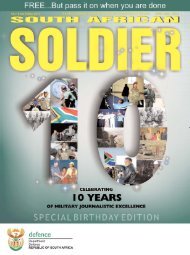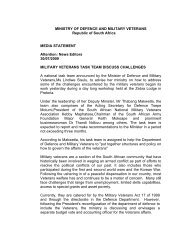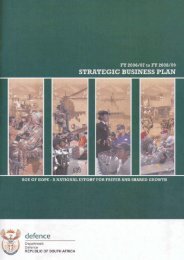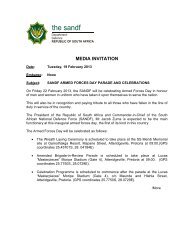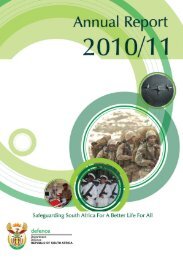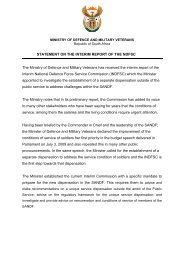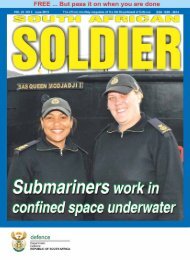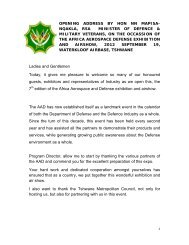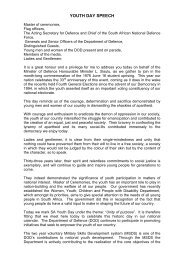Chapter 2 - P rogramme 1 - Department of Defence
Chapter 2 - P rogramme 1 - Department of Defence
Chapter 2 - P rogramme 1 - Department of Defence
Create successful ePaper yourself
Turn your PDF publications into a flip-book with our unique Google optimized e-Paper software.
| <strong>Chapter</strong> 2 - P<strong>rogramme</strong> 1: Administration |<br />
•<br />
•<br />
•<br />
•<br />
•<br />
•<br />
employed by the DOD to Armscor, with effect<br />
from 1 September 2007.<br />
Since the implementation <strong>of</strong> HR Strategy 2010<br />
throughout the DOD, the rank-age compliance<br />
<strong>of</strong> privates has improved by 40,5%. This has<br />
had a major impact upon the medical fitness<br />
and combat-readiness <strong>of</strong> members within this<br />
rank group, specifically within the SA Army.<br />
A DOD HR Risk Management Committee was<br />
established under the auspices <strong>of</strong> the Chief<br />
Directorate HR Strategic Direction and Policy.<br />
Flowing from this has been the compilation <strong>of</strong><br />
a DOD HR Risk Management Register.<br />
The Chief Director HR Management, Major-<br />
General L.S. Mollo, was appointed as the<br />
chairperson for the International Military<br />
History Congress that was held in Cape Town<br />
during August 2007. The congress was voted<br />
a huge success and was attended by delegates<br />
from all over the world.<br />
The HR Division, through the <strong>of</strong>fices <strong>of</strong> the<br />
Chief Directorate Human Resource<br />
Development, is in the process <strong>of</strong> reviewing<br />
and implementing the Human Resource<br />
Development Strategy for the DOD,<br />
initiating the alignment <strong>of</strong> this strategy with<br />
Government’s Resource Development Strategy<br />
as pronounced by the <strong>Department</strong> <strong>of</strong> Public<br />
Service and Administration as being the focus<br />
during 2007/2008. This strategy has, as one <strong>of</strong><br />
its end states, the building <strong>of</strong> the DOD into a<br />
learning organisation, an end state that will be<br />
realised in the foreseeable future.<br />
The HR Division has engaged in various<br />
interventions to embrace and augment<br />
Government’s ASGISA objectives. One <strong>of</strong><br />
these interventions includes an intake <strong>of</strong><br />
voluntary interns to provide unemployed<br />
graduates with between three and 12 months’<br />
relevant occupational work experience. A pilot<br />
project <strong>of</strong> eight interns was launched during<br />
2007/2008. Two <strong>of</strong> the initial four interns were<br />
appointed in permanent posts in the DOD and<br />
a third is in the process <strong>of</strong> being appointed. The<br />
planned intake <strong>of</strong> interns for 2008/2009 is 60.<br />
As part <strong>of</strong> the newly-established HR Division, the<br />
Functional Competency Authority for Human<br />
Resource Practitioners and Education, Training<br />
and Development Practitioners was activated<br />
Annual Report FY 2007 - 2008<br />
| <strong>Department</strong> <strong>of</strong> <strong>Defence</strong> |<br />
64<br />
•<br />
•<br />
•<br />
with effect from 1 April 2007. Achievements <strong>of</strong><br />
the Functional Competency Authority include<br />
awarding a first Human Resource Management<br />
Certificate to a core group <strong>of</strong> human resources<br />
practitioners to facilitate the accreditation <strong>of</strong><br />
Personnel Services School. A competency pr<strong>of</strong>ile<br />
for the Human Resource Practitioners Corps<br />
was also developed to assist with the acquisition<br />
<strong>of</strong> members into the corps. The syllabus for the<br />
training <strong>of</strong> human resources practitioners was<br />
expanded with new modules <strong>of</strong> training such<br />
as the service delivery module, thus enhancing<br />
service delivery improvement amongst human<br />
resources practitioners in the DOD.<br />
The fledgling Warrant Officers Academy<br />
achieved full accreditation status with the South<br />
African Qualifications Authority, which means<br />
that all training presented at the unit will be<br />
credit-bearing training, which is transportable<br />
to the civilian sector should members exit the<br />
DOD.<br />
The DOD Youth Foundation Training<br />
P<strong>rogramme</strong> gave the DOD the ability to create its<br />
own pool <strong>of</strong> suitable candidates for employment<br />
by lifting disadvantaged learners who did not<br />
qualify for initial entry into the DOD up to a<br />
level where they did qualify for entry into the<br />
DOD. The 2007 p<strong>rogramme</strong> was successfully<br />
completed, with 240 learners completing the<br />
p<strong>rogramme</strong>, <strong>of</strong> which 180 learners were taken<br />
into the full-time employment <strong>of</strong> the DOD, with<br />
the remainder being released into the open job<br />
market with a better chance <strong>of</strong> employment. For<br />
various reasons this p<strong>rogramme</strong> was curtailed<br />
at the end <strong>of</strong> 2007 within the DOD, although<br />
the reinstitution there<strong>of</strong>, perhaps in a different<br />
format, is currently under investigation.<br />
The Service Corps succeeded in achieving its<br />
objectives through providing portable skills<br />
to beneficiaries to enhance their employability<br />
and entrepreneurial competencies. The eight<br />
regional <strong>of</strong>fices <strong>of</strong> the Service Corps facilitated<br />
training for DOD members who opted to<br />
take the Mobility Exit Mechanism (MEM), the<br />
Employee Initiated Severance Package (EISP),<br />
or departmental transfer to the South African<br />
Police Services (SAPS), as well as providing<br />
support to military veterans. The Service Corps<br />
provided and facilitated training for 2 380<br />
beneficiaries.



